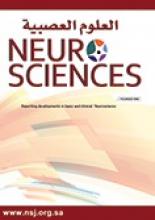Case ReportCase Report
Open Access
Conus medullaris stroke
Does F wave predict return of ambulation?
Mohammed H. Alanazy
Neurosciences Journal July 2016, 21 (3) 260-263; DOI: https://doi.org/10.17712/nsj.2016.3.20150554
Mohammed H. Alanazy
From the Division of Neurology, Department of Medicine, King Saud University, Riyadh, Kingdom of Saudi Arabia
MD, FRCPC
References
- ↵
- Preston D,
- Shapiro B
- Preston D,
- Shapiro B
- ↵
- Shibazaki K,
- Yoneda Y,
- Sunada Y,
- Tabuchi M
- ↵
- Hiersemenzel LP,
- Curt A,
- Dietz V
- ↵
- Thompson TP,
- Pearce J,
- Chang G,
- Madamba J
- ↵
- Chang CW,
- Donovan DJ,
- Liem LK,
- O’Phelan KH,
- Green DM,
- Bassin S,
- et al.
- ↵
- Luo CB,
- Chang FC,
- Teng MM,
- Chen SS,
- Lirng JF,
- Chang CY
- ↵
- Alblas CL,
- Bouvy WH,
- Lycklama ÀNijeholt GJ,
- Boiten J
- ↵
- Amano Y,
- Machida T,
- Kumazaki T
- ↵
- Kawaguchi C,
- Niwa K,
- Hamano H,
- Haida M,
- Shinohara Y
In this issue
Conus medullaris stroke
Mohammed H. Alanazy
Neurosciences Journal Jul 2016, 21 (3) 260-263; DOI: 10.17712/nsj.2016.3.20150554
Jump to section
Related Articles
- No related articles found.
Cited By...
- No citing articles found.





